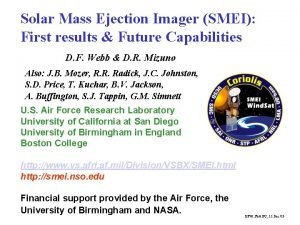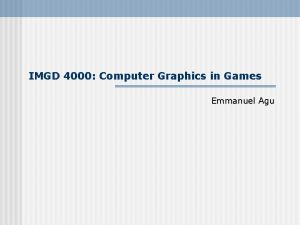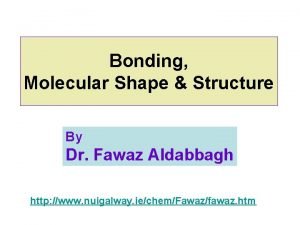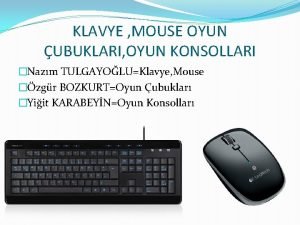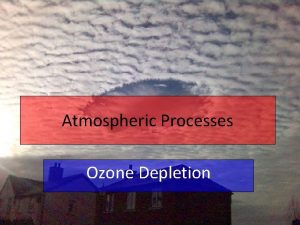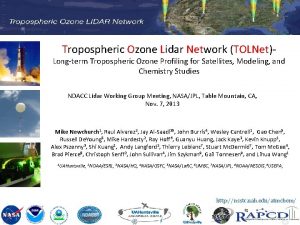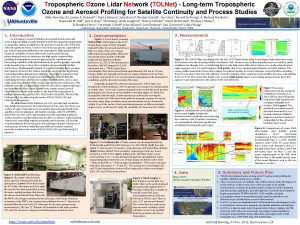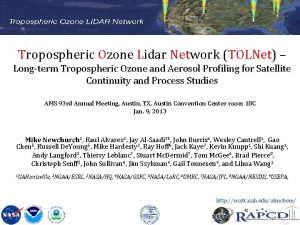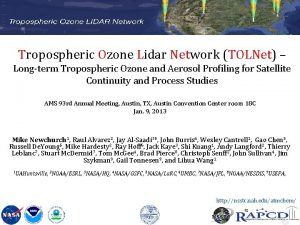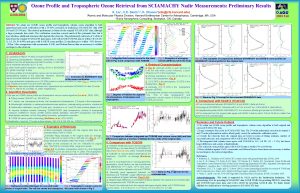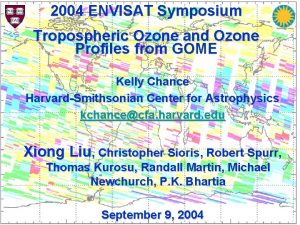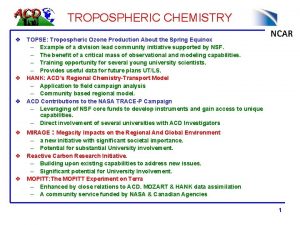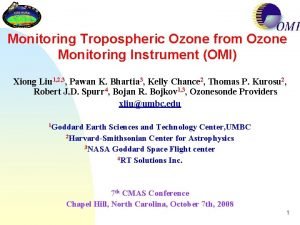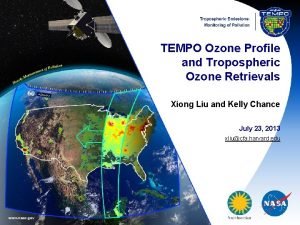2004 AGU Fall Meeting Direct Tropospheric Ozone Retrieval













- Slides: 13

2004 AGU Fall Meeting Direct Tropospheric Ozone Retrieval from GOME Xiong Liu Harvard-Smithsonian Center for Astrophysics xliu@cfa. harvard. edu Kelly Chance, Christopher Sioris, Robert Spurr, Thomas Kurosu, Randall Martin, Mike Newchurch, PK Bhartia San Franciso, CA December 17, 2004 1

Outline n Introduction n Algorithm description n Intercomparison with Ozonesonde, TOMS, and Dobson n Global distribution of tropospheric ozone and comparison with GEOS-CHEM model results n Summary and future work 2

Introduction n GOME: first nadir-viewing satellite instrument that allows direct tropospheric ozone retrieval from the space. n Several groups [Munro et al. , 1998; Hoogen et al. , 1999; Hasekamp et al. , 2001; van der A et al, 2002; Muller et al. , 2003; Liu et al. , 2004] have developed ozone profile retrieval algorithms from GOME: each of them demonstrates that limited tropospheric ozone information can be derived. n However, tropospheric ozone retrieval remains very challenging from GOME: u Require accurate and consistent calibrations. u Need to fit the Huggins bands to high precision. u Tropospheric ozone is only ~10% of total column ozone. 3

Algorithm Description n Inversion technique: Optimal Estimation n Measurements: 289 -307 nm, 326 -338 nm; Spatial resolution: 960× 80 km 2 n Perform detailed wavelength and radiometric calibrations: ØDerive variable slit widths and shifts between radiances/irradiances ØFit shifts between trace gas absorption cross-sections and radiances ØCo-add adjacent pixels from 289 -307 nm to reduce noise ØImprove polarization correction using GOMECAL (www. knmi. nl/gome_fd/) ØPerform undersampling correction with a high-resolution solar reference ØFit degradation for 289 -307 nm on line in the retrieval n Use LIDORT to simulate radiances and weighting functions n Improve forward model simulation: ØOn-line correction of Ring filling in of the solar and telluric absorption feature with first-order single scattering RRS model [Sioris and Evans, 2002] ØLook-up table correction of polarization errors [van Oss, personal comm. ] ØMonthly-mean SAGE stratospheric aerosols [Bauman et al. , 2003] ØGEOS-CHEM tropospheric aerosols [Martin et al. , 2002] 4

Algorithm Description n Improve forward model simulation (continue): ØBrion’s ozone absorption cross-sections [Brion et al. , 1993] ØDaily ECMWF temperature profiles (www. ecmwf. int) ØDaily NCEP/NCAR surface pressure (www. cdc. noaa. gov) ØCloud-top height from GOMECAT [Kurosu et al. , 1999] ØCloud fraction derived at 370. 2 nm with albedo database [Kolemeijer et ØWavelength dependent albedo (2 -order polynomial) from 326 -338 nm al. , 2003] A priori: latitude and monthly dependent TOMS V 8 climatology (a priori and its variance) [Mc. Peters et al. , 2003, AGU] n n Retrieval Grid: 11 layers, almost the same as the Umkehr grid Ø Ø n Bottom 2 -3 layers are modified by tropopause/surface pressure Tropospheric column ozone is directly retrieved State Vector: 47 parameters 11 O 3 + 4 albedo (1 for ch 1 a & 3 for ch 2 b) + 4 Ring (1 for ch 1 a & 3 for ch 2 b) + 8 O 3 shift + 8 rad. /irrad. shift + 3 degradation correction (ch 1 a only) + 2 undersampling + 2 NO 2 + 2 Br. O + 2 SO 2 + 1 internal scattering Ø n Fitting residual: 0. 40% for band 1 a, 0. 17% for band 2 b, 0. 3% for both n Speed : ~17 hours on a 2 GHz processor for one day, could be operational 5

Validation and Intercomparison GOME data are collocated at 25 ozonesonde stations during 96 -99. n Validate retrievals against TOMS V 8, Dobson/Brewer total ozone, and ozonesonde. n Ozonesonde data mostly from WOUDC, and some from CMDL, SHADOZ, and NDSC. n Collocation criteria: n Ø Within ~8 hours, 1. 5° latitude and ~500 km in longitude Ø Average all TOMS points within GOME footprint Number of comparisons: 4429, 952, and 1937 with TOMS, Dobson, and ozonesonde, respectively. n http: //www. woudc. org; http: //croc. gsfc. nasa. giv/shadoz http: //ndsc. ncep. noaa. gov; http: //toms. gsfc. nasa. gov/ http: //www. cmdl. noaa. gov/infodata/ftpdata. html 6

Total Column Ozone Comparison GOME-TOMS: within retrieval uncertainties and saptiotemporal variability. n ØBiases: <3 DU except 38 DU at a few highlatitude stations Ø 1 : 2 -4 DU in the tropics, 4 -11 DU at higher latitudes. A Priori Retrieval n. GOME-Dobson: Dobson TOMS within retrieval uncertainties and ozone variability. ØBiases: <5 DU, and <8 DU at two high-latitude stations Ø 1 : 3 -6 DU in the tropics, 6 -19 DU at higher latitudes. 7

Tropospheric Column Ozone Comparison nn. GOME-SONDE withinretrieval uncertainties. ØØBiases: <4 <4 DU DU(15%) except– 5. 5, 4. 4, 5. 6 DU DU (16 -33%)atat. NyÅlesund, Naha, Tahiti Naha, NyÅlesund, ØTahiti 1 : 3 -7 Ø 1 A Priori Retrieval Ozonesonde DU (13 -28%) : 3 -7 DU (13 -28%) 8

Examples of Daily Global Tropospheric Ozone Low tropospheric ozone in tropical Pacific Bands of high ozone at mid-latitudes High ozone over biomass burning South Atlantic Paradox High ozone at high-latitudes during late winter and early spring 9

Monthly Mean Tropospheric Ozone (09/96 -10/97) 10

GOME vs. GEOS-CHEM Tropospheric Ozone SON, 96 R=0. 67 1. 8± 6. 8 DU DJF, 96 -97 R=0. 83 0. 0± 5. 3 DU MAM, 97 R=0. 82 2. 2 ± 4. 5 DU JJA, 97 R=0. 64 2. 5 ± 5. 7 DU 11

Summary n Ozone profiles and tropospheric column ozone are derived from GOME using the optimal estimation approach after detailed treatments of wavelength and radiometric calibrations and improvement of forward model inputs. n Retrieved total ozone compares very well with TOMS and Dobson/Brewer total ozone. n The tropospheric column ozone compare well with ozonesonde measurements. n Global distribution of tropospheric ozone is presented. It clearly shows the signals due to biomass burning, air pollution, stratospherictroposphere exchange, transport and convection. n The overall structures of retrieved tropospheric ozone are similar to those of GEOS-CHEM, but significant differences exist. 12

Future Work n Retrieve tropospheric ozone for the 8 -year GOME data record and apply the algorithm to SCIMACHY data n With the aid of GEOS-CHEM, investigate global/regional distribution of tropospheric ozone and understand the GOME/GEOS-CHEM similarities and differences. n Tropospheric ozone radiative forcing n Tropospheric/stratospheric ozone variability Acknowledgements n. This study is supported by the NASA ACMAP and by Smithsonian Institution. n. We thank WOUDC and its data providers, SHADOZ, CMDL, NDSC, TOMS, and M. Fujiwara for providing correlative measurements. n. We are grateful to M. Fu and P. I. Palmer for providing the GEOS-CHEM model results. n. We thank R. van Oss for providing look-up table and software for correcting radiance errors due to neglect polarization. 13
